Photographer’s dream shoot — Antarctica
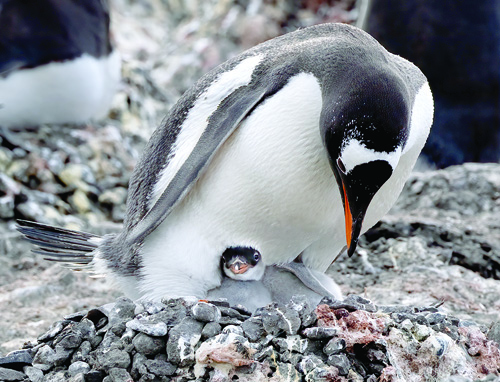
By Dawn De Busk
Staff Writer
CASCO — Being a photographer has given Brien Richards the opportunity to travel to many places around the world, including most recently, Antarctica.
“Antarctica is a photographer’s dream. There’s so much to photograph from the vast icy landscapes and floating icebergs to the huge array of wildlife like humpback whales, seabirds, orcas, and, of course, penguins,” Richards said.
He told a story, giving testament to how amazing Antarctica is to photograph.
“My daughter Audra borrowed my Nikon Z6 camera and 70-200mm lens and took more than 4,000 photos. She said she was holding back (on the number of photos she was taking). To date, she has not returned the camera,” Richards joked.
Actually, she had persuaded him to upgrade.
“She knew that there was a Nikon Z6ii available and shamed me into giving her the old one, along with the lens, and upgrading mine,” he said. “She never intended to take photos, but ride along, but I think she wanted to capture her own images for later memories,” he said.
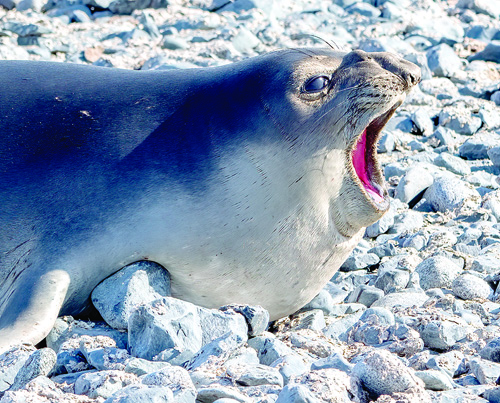
His daughter Audra volunteered to be his sidekick on the trip to Antarctica because
Richards’ wife stayed firm to her decision not to get on the ship going through The Drake Passage. That route was known to have 60-foot seas, he said.
Richards has chosen a lifestyle of pursuing his photographic interests, which involves a lot of traveling
“I’m a retired military officer and a retired federal civil servant — that makes me really old,” he said. “I worked the last 30 years with the Department of the Army in Belgium working with NATO, the North Atlantic Treaty Organization.”
“Photography is my passion and I travel around the country [mainly in national parks] and internationally attending photo workshops that allow me to meet like-minded people in great locations with good instructors,” he said.
Some of his international venues include Greenland, Iceland, Costa Rica and Norway.
Richards traveled to Antarctica in December 2022 — not quite a year ago, during that region’s spring-time.
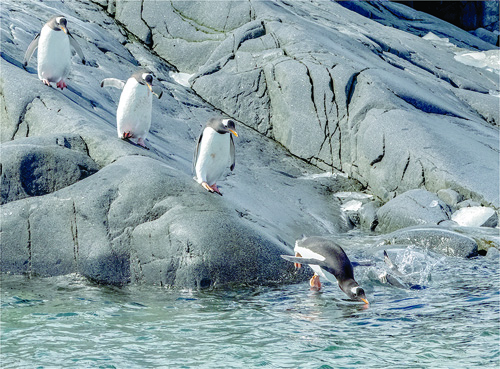
Last Thursday, at the Casco Public Library, Richards shared his trip to Antarctica via his photographs, his stories, and a video provided by Poseidon Expeditions that included drone video of humpback whales. About 20 people attended the library’s presentation; and, those folks ranged from a couple of families with younger children, to older people still in the working force as well as retired residents.
Conservation in Action
Richard’s presentation combined history and geography with a study of nature plus humorous stories of the wildlife.
“You have to go along the Drake Passage, where Charles Darwin left on his voyage about evolution,” he said.
The Drake Passage “is the body of water between South America’s Cape Horn, Chile, Argentina and the South Shetland Islands of Antarctica,” according to Wikipedia.
It is where the Atlantic Ocean meets the Pacific Ocean, Richards said.
“The currents from all the oceans meet. That is why you can never count on a smooth voyage. They kept telling us, ‘This is not a tour. This is an expedition,’” he said.
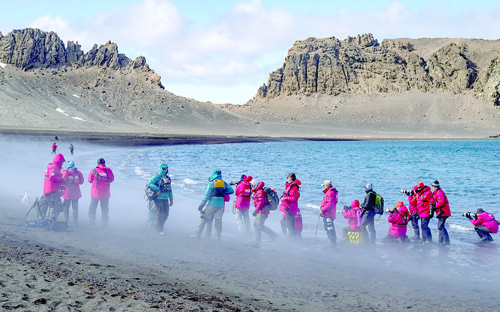
The trip itself was a learning experience. During the two days it took to sail about 600 miles, the passengers were being schooled.
“What are you going to do for two day? We had nine professional photographers, and four naturalists. They gave us all these classes. The naturalists were great to listen to,” he said.
He passed on the history lesson, which is tied to the reason why Antarctica has remained virtually untouched with the exception of exploration and scientific studies.
“There is an Antarctica Treaty of 1959 in which 12 countries signed and agreed that Antarctica could only be used for peaceful purposes and no country had any territorial claims,” he said.
Of all the places Richards has traveled to photograph what he sees, Antarctica is certainly the most uninhabited.
“The thing that struck me most about Antarctica was its vast, pristine environment. After all, it is a whole continent with almost no one on it, except a few nations’ research stations,” he said.
“You see no one except those in your group. No cars, no boats, no roads. It looks like what one would imagine the world looked like before man (and woman) arrived,” he said.
Certain rules have been established to protect the fragile environments, he said.
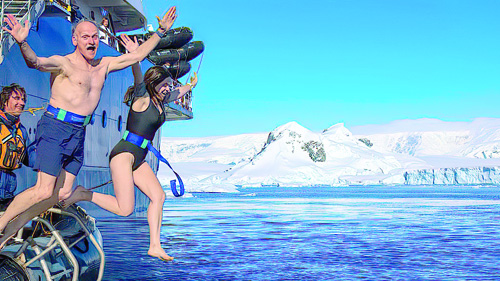
“There are a few protocols that call for no harassment of wildlife, leave nothing behind, no kneeling or lying on the ground, except right on the rocky beach, cleaning boots before and after zodiac landings, etc,” he said.
“We were not allowed to even pee on the land. If you had to go, there was a Zodiac that took you back to the cruise ship. No kidding,” he said.
Another conservation-based policy: No two cruise ships can land in the same place, he said.
Wonders of Wildlife
Richards got a lot of front-row learning about penguins during his 11-day trip to Antarctica in December, which just happens to be that region’s spring. In reality, that trip was about two weeks earlier than when most penguins hatch. However, the Maine-based photographer did manage to catch one ‘early bird,’ a penguin chick born sooner than the hatching season.
Also, Richards witnessed a lot of courtship scenes centered on tiny pebbles used for the nests.
He told the audience that Antarctica has no trees to use for nest.
“They build their nests out of these pebbles. If he is a young, newly married penguin and he really loves her, he will bring her pebbles,” he said. “How do they find the pebbles? They steal them from other nests while those penguins are gone. The males fight back and forth over pebbles.”
He described a penguin sneaking over to get that pebble and losing it, and spending hours searching for that one pebble. Pebbles are a priority in the life of a penguin, he said.
“Their tails and wings help to balance them on land. They are funnier than heck. They will be walking along, and just do a face plant,” he said. “The penguins are extremely agile in the water.”
“A group of penguins is called a waddle. If floating together, they are called a raft. The Gentoo penguin is the fastest. They can swim up to 22 mph. They can dive down 600 feet. But, the great big orca can swim 35 to 40 mph, which puts the penguin at a disadvantage,” Richards said.
“Penguins can live 15 to 20 years in the wild. Somewhere around 30 years in captivity without predators,” he said.
One strange thing he noticed is that there were no nights, no darkness during his trip.
“It never got dark, not fully dark. The sun would set, but not much,” he said.
Wildlife briefings were built into the structure of the days.
“We ran into some humpback whales. The humpback go for krill shrimp. There was a professional photographer on board, and he had a drone. At the end of tour, they gave us a video,” he said.
To see more pictures from Richards’ trip to Antarctica or other trips or other wildlife, go to his website brienrichards.smugmug.com. The name of his business is Brien Richards Photography.


